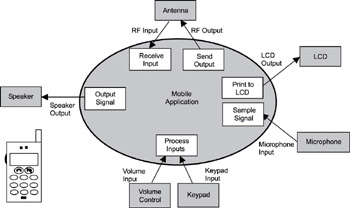Книга: Real-Time Concepts for Embedded Systems
14.2 An Outside-In Approach to Decomposing Applications
14.2 An Outside-In Approach to Decomposing Applications
In most cases, designers insist on a set of requirements before beginning work on a real-time embedded system. If the requirements are not fully defined, one of the first activities is to ensure that many of these requirements are solidified. Ambiguous areas also need to be fleshed out. The detailed requirements should be captured in a document, such as a Software Requirements Specification (SRS). Only then can an engineering team make a reasonable attempt at designing a system. A high-level example of a mobile phone design is provided to show how to decompose an application into concurrent units of execution.
Commonly, decomposing an application is performed using an outside-in approach. This approach follows a process of identifying the inputs and outputs of a system and expressing them in a simple high-level context diagram. A context diagram for the mobile application is illustrated in Figure 14.1. The circle in the center of the diagram represents the software application. Rectangular boxes represent the input and output devices for this application. In addition, arrows, labeled with meaningful names, represent the flow of the input and output communications. For the sake of simplicity, not all components (i.e., battery, input for hands-free ear plug, input for external power, and power on/off button) are illustrated.

Figure 14.1: High-level context diagram of a mobile handheld unit.
The diagram shows that mobile handset application provides interfaces for the following I/O devices:
· antenna,
· speaker,
· volume control,
· keypad,
· microphone, and
· LCD.
The following inputs are identified:
· RF input,
· volume input,
· keypad input, and
· microphone input.
The following outputs are identified:
· RF output,
· speaker output, and
· LCD output.
After the inputs and outputs are identified, a first cut at decomposing the application can be made. Figure 14.2 shows an expanded diagram of the circle identifying some of the potential tasks into which the application can decompose. These tasks are along the edges of the newly drawn application, which means they probably must interact with the outside world. Note that these tasks are not the only ones required, but the process provides a good starting point. Upon further analysis, additional tasks may be identified, or existing tasks may be combined as more details are considered.

Figure 14.2: Using the outside-in approach to decompose an application into tasks.
Some inputs and outputs in a handheld mobile device can require more than one dedicated task to handle processing. Conversely, in some cases, a single task can handle multiple devices. Looking at the example, the antenna can have two tasks assigned to it-one for handling the incoming voice channel and one for handling the outgoing voice channel. Printing to the LCD can be a relatively simple activity and can be handled with one task. Similarly, sampling the input voice from the microphone can also be handled with one task for now but might require another task if heavy computation is required for sampling accuracy. Note that one task can handle the input keys and the volume control. Finally, a task is designated for sending the output to the speaker.
This example illustrates why the decomposition method is called outside-in: an engineering team can continue this way to decompose the overall application into tasks from the outside in.
- Chapter 14: Modularizing An Application For Concurrency
- Compiling the user-land applications
- CHAPTER 6 Productivity Applications
- Available Applications
- Productivity Applications Written for Microsoft Windows
- Lesson 2: Implementing System Applications
- Chapter 15. Debugging Embedded Linux Applications
- 15.4.2. Debugging Multithreaded Applications
- Controlling access to DNS servers outside the organization
- Restoring applications, nonsystem volumes, and files and folders
- Chapter 17 Developing ASP.NET Web Applications
- 10.3 Applications of Exceptions and Interrupts




